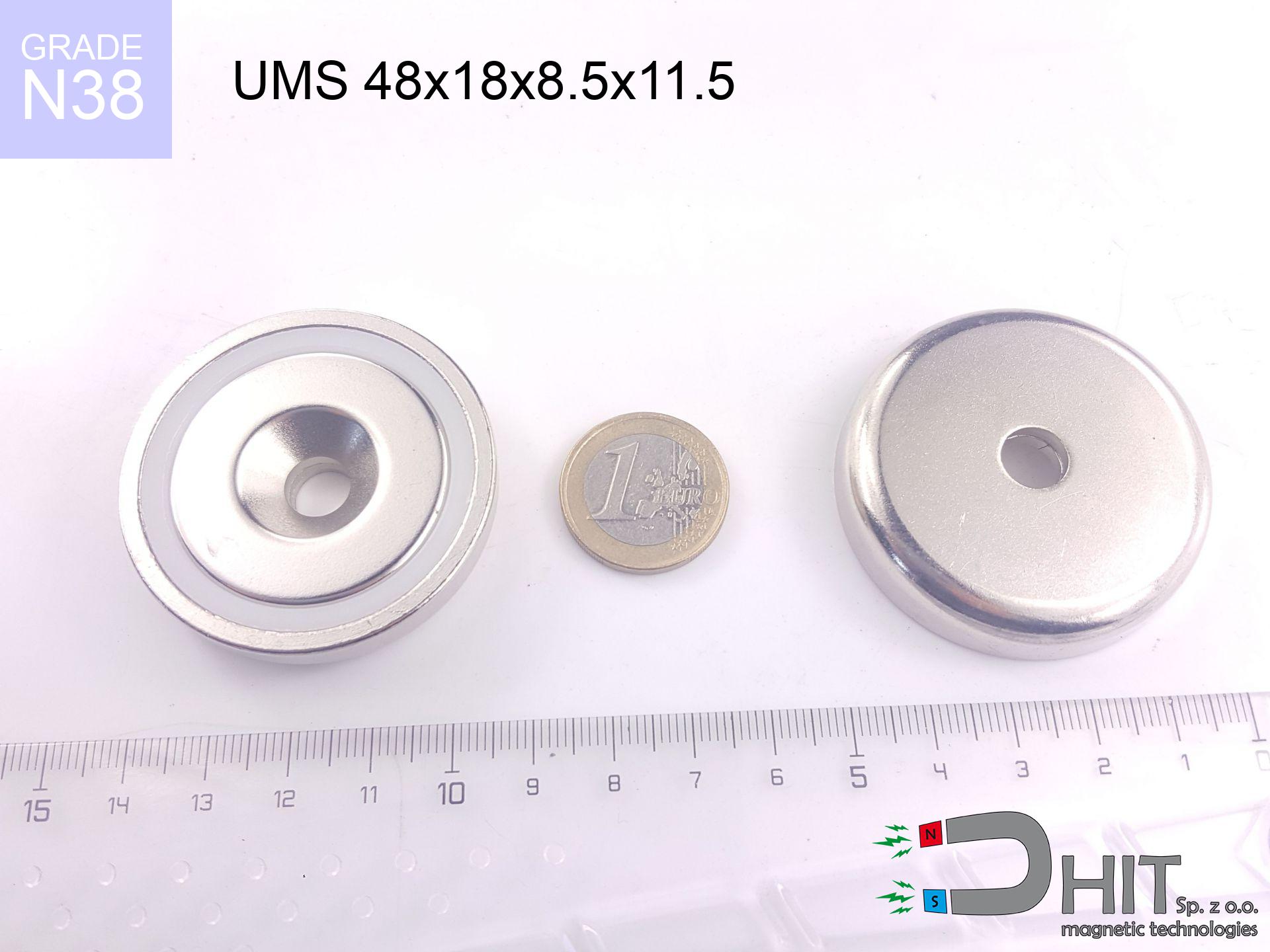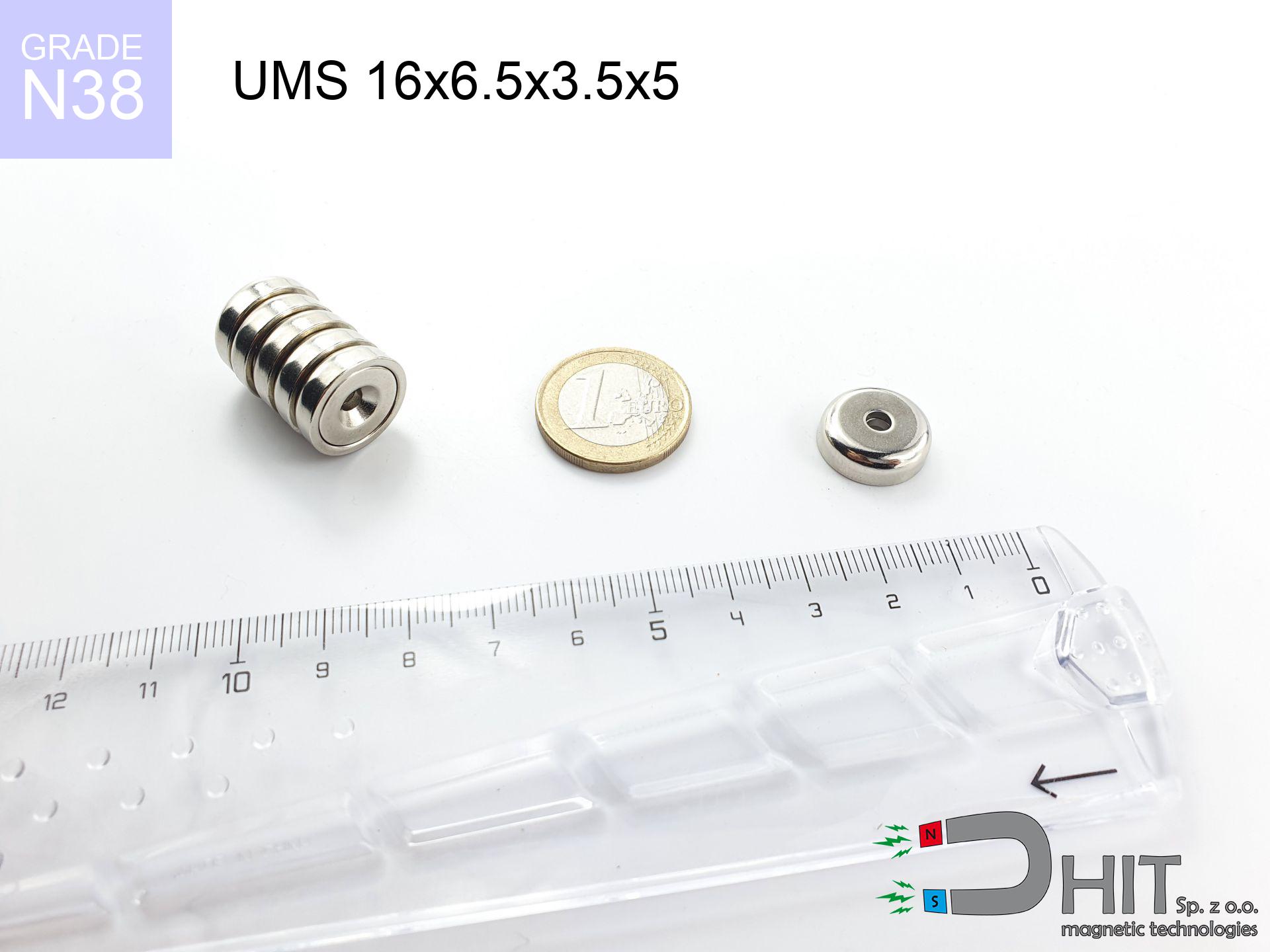UMS 48x18x8.5x11.5 / N38
conical magnetic holder
catalog number 220403
GTIN: 5906301814221
diameter Ø
48 mm [±0,1 mm]
cone dimension Ø
18x8.5 mm [±0,1 mm]
height
11.5 mm [±0,1 mm]
capacity ~
68.00 kg / 666.85 N
max. temperature
≤ 80 °C
44.92 PLN gross price (including VAT) / pcs +
36.52 PLN net price + 23% VAT / pcs
bulk discounts:
need more quantity?Want to bargain?
Call us tel: +48 22 499 98 98 or contact us via contact form on our website. You can check the power as well as the appearance of neodymium magnet in our force calculator magnetic mass calculator
Orders placed by 2:00 PM will be shipped on the same business day.
Specification: conical magnetic holder 48x18x8.5x11.5 / N38
Magnetic properties of the material N38
Physical properties of sintered neodymium magnets Nd2Fe14B
Find suggested articles
Advantages as well as disadvantages of neodymium magnets NdFeB.
In addition to immense strength, neodymium magnets have the following advantages:
- They do not lose their strength (of the magnet). After about 10 years, their power decreases by only ~1% (theoretically),
- They are extremely resistant to demagnetization by external magnetic field,
- By applying a shiny coating of nickel, gold, or silver, the element gains an aesthetic appearance,
- They have exceptionally high magnetic induction on the surface of the magnet,
- Thanks to their high temperature resistance, they can operate (depending on the shape) even at temperatures up to 230°C and above...
- The ability for precise shaping and customization to specific needs – neodymium magnets can be produced in a wide range of shapes and sizes, which enhances their versatility in applications.
- Wide application in advanced technologically fields – are utilized in computer drives, electric drive mechanisms, medical apparatus or very modern machines.
Disadvantages of neodymium magnets:
- They can break when subjected to a powerful impact. If the magnets are exposed to impacts, we recommend using magnets in a steel housing. The steel housing in the form of a holder protects the magnet from impacts and at the same time increases its overall strength,
- High temperatures can reduce the power of neodymium magnets. Typically, after heating above 80°C, most of them experience a permanent reduction in strength (although it is dependent on the form and size). To prevent this, we offer special magnets marked with the symbol [AH], which are highly resistant to high temperatures. They can operate even at temperatures up to 230°C, making them an ideal solution for applications requiring high-temperature operation,
- They rust in a humid environment. For outdoor use, we recommend using waterproof magnets, such as those made of rubber or plastic,
- The use of a cover or a magnetic holder is recommended due to the limited possibilities of manufacturing threads or complex shapes in the magnet
- Potential hazard associated with microscopic parts of magnets pose a threat, when accidentally ingested, which is particularly important in the aspect of protecting young children. Additionally, small elements of these devices have the potential to complicate diagnosis after entering the body.
Exercise Caution with Neodymium Magnets
Do not give neodymium magnets to children.
Remember that neodymium magnets are not toys. Do not allow children to play with them. They can be a significant choking hazard. If multiple magnets are swallowed, they can attract to each other through the intestinal walls, causing severe injuries, and even death.
Dust and powder from neodymium magnets are highly flammable.
Avoid drilling or mechanical processing of neodymium magnets. Once crushed into fine powder or dust, this material becomes highly flammable.
Neodymium magnets can become demagnetized at high temperatures.
Although magnets have shown to retain their effectiveness up to 80°C or 175°F, this temperature may vary depending on the type of material, shape, and intended use of the magnet.
The magnet coating is made of nickel, so be cautious if you have an allergy.
Studies show a small percentage of people have allergies to certain metals, including nickel. An allergic reaction often manifests as skin redness and rash. If you have a nickel allergy, you can try wearing gloves or simply avoid direct contact with nickel-plated neodymium magnets.
Neodymium magnetic are highly delicate, they easily fall apart and can crumble.
In the event of a collision between two neodymium magnets, it can result in them getting chipped. Despite being made of metal and coated with a shiny nickel plating, they are not as hard as steel. At the moment of connection between the magnets, tiny sharp metal fragments can be propelled in various directions at high speed. Eye protection is recommended.
Keep neodymium magnets away from the wallet, computer, and TV.
Neodymium magnets generate intense magnetic fields that can destroy magnetic media such as floppy disks, video tapes, HDDs, credit cards, magnetic ID cards, cassette tapes, or other devices. They can also destroy devices like video players, televisions, CRT computer monitors. Do not forget to keep neodymium magnets at a safe distance from these electronic devices.
Keep neodymium magnets away from GPS and smartphones.
Magnetic fields interfere with compasses and magnetometers used in navigation for air and sea transport, as well as internal compasses of smartphones and GPS devices.
Keep neodymium magnets away from people with pacemakers.
Neodymium magnets produce strong magnetic fields that can interfere with the operation of a heart pacemaker. However, if the magnetic field does not affect the device, it can damage its components or deactivate the device when it is in a magnetic field.
It is crucial not to allow the magnets to pinch together uncontrollably or place your fingers in their path as they attract to each other.
In the case of holding a finger in the path of a neodymium magnet, in such a case, a cut or a fracture may occur.
Neodymium magnets are among the most powerful magnets on Earth. The astonishing force they generate between each other can surprise you.
On our website, you can find information on how to use neodymium magnets. This will help you avoid injuries and prevent damage to the magnets.
To illustrate why neodymium magnets are so dangerous, see the article - How very dangerous are strong neodymium magnets?.




![search holder 75x25 [M10x3] GW F200 GOLD / N42 search holder 75x25 [M10x3] GW F200 GOLD / N42](https://cdn3.dhit.pl/graphics/products/ump-75x25-m10x3-gw-f200-gold-pag.jpg)

![magnetic separator 32x325 [2xM8] / N52 magnetic separator 32x325 [2xM8] / N52](https://cdn3.dhit.pl/graphics/products/sm-32x325-2xm8-xec.jpg)
![badge holder 45x13x5 [M301] / N38 badge holder 45x13x5 [M301] / N38](https://cdn3.dhit.pl/graphics/products/ui45x13x5-m301-vud.jpg)

